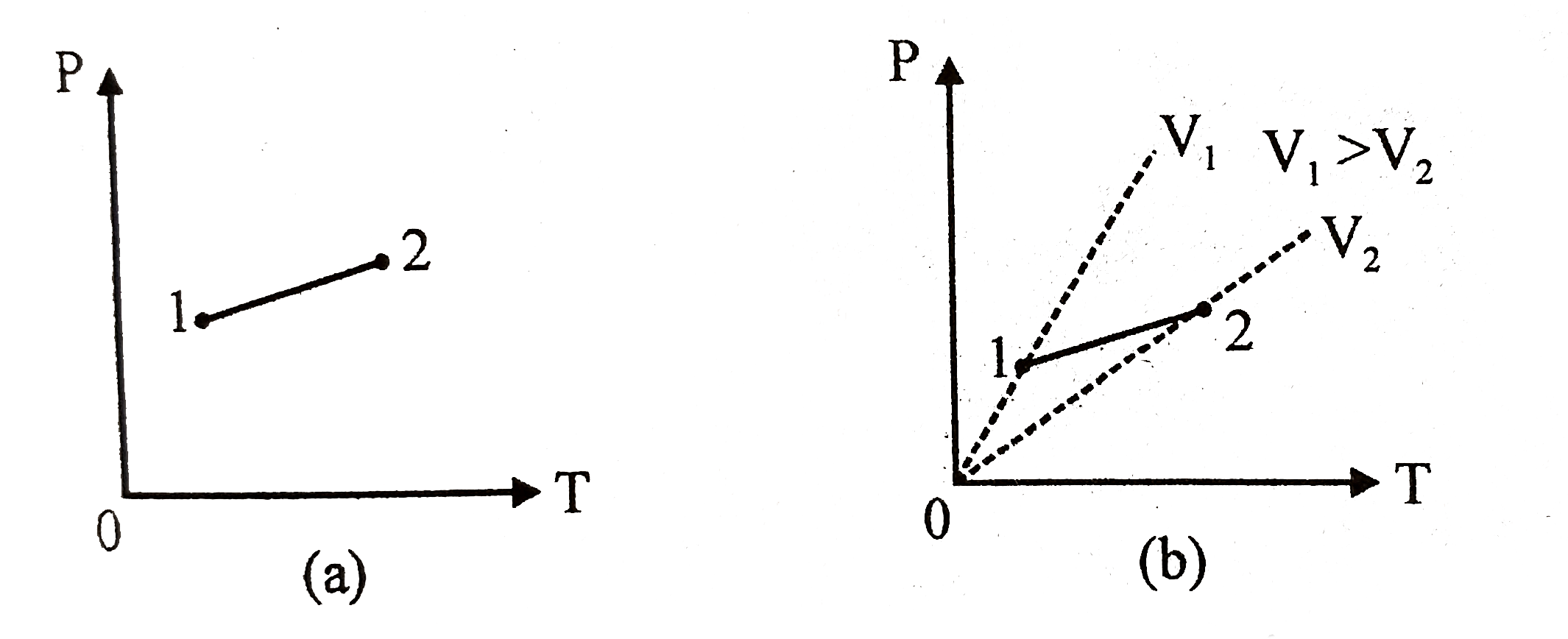An ideal gas is subjected to the following changes. Answer the following questions:
(a) A curve showing the dependence of pressure on absolute temperature was obtained for a certain gas. Does compression or expansion takes place when the gas is being heated [constant moles]?
![An ideal gas is subjected to the following changes. Answer the following questions: (a) A curve showing the dependence of pressure on absolute temperature was obtained for a certain gas. Does compression or expansion takes place when the gas is being heated [constant moles]? {:(](https://d10lpgp6xz60nq.cloudfront.net/physics_images/GRB_PHY_CHM_P2_V03_QB_C13_E01_434_Q01.png)
CodeProcess1Compression2Expansion
(b) Use the volume temperature curve to find graphically the nature of change in the pressure of a gas during heating [constant moles.]

CodeProcess3Increases4Decreases5Remains constant
(c) The piston in a gas filled cylinder is lossely fitted aganist the wall of the cylinder and can slowly let the gas go past it. The volume temperature curve for the gas at constant pressure has the form shown in the figure. Use this curve to determine whether the amount of gas in the cylinder has increased or decreased.

CodeAmount of Gas6Increases7Decreases8Remains constant
Write your answer as "abc", for example if your answer is code: 1,4,8 the, write your answer as 148.
The correct Answer is:247
Step by step video, text & image solution for An ideal gas is subjected to the following changes. Answer the following questions: (a) A curve showing the dependence of pressure on absolute temperature was obtained for a certain gas. Does compression or expansion takes place when the gas is being heated [constant moles]? {:("Code","Process"),(1,"Compression"),(2,"Expansion"):} (b) Use the volume temperature curve to find graphically the nature of change in the pressure of a gas during heating [constant moles.] {:("Code","Process"),(3,"Increases"),(4,"Decreases"),(5,"Remains constant"):} (c) The piston in a gas filled cylinder is lossely fitted aganist the wall of the cylinder and can slowly let the gas go past it. The volume temperature curve for the gas at constant pressure has the form shown in the figure. Use this curve to determine whether the amount of gas in the cylinder has increased or decreased. {:("Code","Amount of Gas"),(6,"Increases"),(7,"Decreases"),(8,"Remains constant"):} Write your answer as "abc", for example if your answer is code: 1,4,8 the, write your answer as 148. by Chemistry experts to help you in doubts & scoring excellent marks in Class 12 exams.
Updated on:21/07/2023Topper's Solved these Questions
- GRAPHICAL INTERPRETATIONBook:GRB PUBLICATIONChapter:GRAPHICAL INTERPRETATIONExercise:Match The Column Type
Explore 15 Videos
- F-BLOCK ELEMENTSBook:GRB PUBLICATIONChapter:F-BLOCK ELEMENTSExercise:Subjective type
Explore 7 Videos
- HYDROCARBON (ALIPHATIC)Book:GRB PUBLICATIONChapter:HYDROCARBON (ALIPHATIC)Exercise:Previous years jee questions
Explore 28 Videos
Similar Questions
Knowledge Check
For an ideal gas the fractional change in its volume per degree rise in temperature at constant pressure is equal to [T is absolute temperature of gas]
AT0BTCT−1DT2A volume V absolute temperature T diagram was obtained when a given mass of gas was heated. During the heating process from state 1 to 2, the pressure
_E01_062_Q01.png) ARemain constantBDecreasedCChanged erraticallyDIncreased
ARemain constantBDecreasedCChanged erraticallyDIncreasedWhen a gas is compressed as constant temperature:
Athe speeds of the molecules increaseBthe collisions between the molecules increaseCthe speeds of the molecules decreaseDthe collisions between the molecules decrease
An ideal gas undergoing adiabatic change has the following pressure-temperature relationship
View SolutionAn ideal gas in a cylinder is slowly compressed to one third of its original volume. During this process, the temperature of the gas remains constant and the work done in compression is 75 J. How much heat flows into the gas ?
View SolutionWhen a gas is compressed at constant temperature
View SolutionOne mole of an ideal gas requires 207 J heat to raise the temperature by 10K When heated at constant pressure. If the same gas is heated at constant volume to raise the temperature by 5K, then the heat required is
View SolutionAn ideal gas undergoes isothermal expansion at constant pressure . During the process.
View Solution


 " "
" "